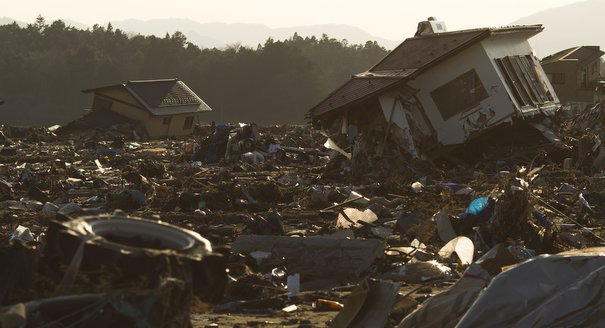Registration
You will receive an email confirming your registration.
Charles Aanenson and Jon Ehrenfeld, the two principal authors of the report Strengthening the Alliance—HA/DR Cooperation in the Asia-Pacific, discussed the role of disaster relief in the Japanese-U.S. security alliance. The discussion centered principally on the two-year Japan-U.S. Civil-Military Disaster Preparedness Initiative, funded by the Japan Foundation Center for Global Partnership and the Smith Richardson Foundation, and recently completed by Peace Winds America.
Retired Lieutenant General W.C. “Chip” Gregson, senior director for China and the Pacific at the Center for the National Interest, and retired Lieutenant General Noboru Yamaguchi JGSDF, professor and director of international studies at the Japan National Defense Academy, joined the discussion. Jim Schoff moderated.
Discussion Highlights
- Information is Valuable: Information is needed from both the supply and demand side, to evaluate the situation on-the-ground and determine what resources are needed, panelists agreed. Thus, efficient information gathering and sharing is crucial, especially in the days immediately following a disaster.
- Local Empowerment: Involving locals and the right leadership officials is an important principle in disaster relief, panelists said. To this end, the allies can coordinate efforts to build local capacity and aim to transition relief activities to the host country sooner rather than later.
- Need to Strengthen Interagency Cooperation and Communication: Cooperation and communication need to be strengthened not just among civilian and military units, but also NGOs, the UN, private sector, and other stakeholders, participants said. Joint discussions and preparedness training can provide a better understanding of roles, missions, and capabilities before disaster strikes. This enables countries working together after a disaster to build on one another’s complementing capacities.
- Sustained Personal-level Connections: Maintaining personal connections between various actors beforehand provides the foundation for effective communication and coordinated responses when a disaster occurs, discussants said.
- Lack of International Coordination: To address the issue of chaotic international coordination, some participants highlighted the importance of a standing bureaucracy to manage the international relief efforts, while others felt that establishing a rigid template would be ineffective given how disaster and national circumstances can vary drastically. Nonetheless, joint preparations, workshops, and exercises beforehand are valuable lines of communication, all agreed. Another participant noted the difference between planning and execution: tabletop exercises are multilateral but the mode of initial responses usually remains bilateral.
- Host Nation Capability: The capabilities of the nation affected by the disaster are a critical factor in disaster relief, participants said. They pointed out that there is not a simple divide between developed and developing countries. For example, New Zealand was able to control and manage disaster response effectively, and articulate what it wanted or did not need. In contrast, there was insufficient process of coordination or information gathering and sharing in Japan after the Fukushima disaster. Participants suggested that Tokyo needs to change its bureaucratic mindset of distributing roles among different government agencies, and increase centralization of capacity in the Prime Minister’s office. A revised NSC structure could help, some said.
- Humanitarian Assistance and Disaster Relief (HA/DR) in the U.S.-Japan Alliance: The bilateral alliance between Japan and the United States has facilitated quick deployment of resources and manpower to disaster areas around the world, while capitalizing on the comparative advantages of the two countries, participants said. U.S. capabilities in massive and rapid mobilization are complemented by Japan’s longer-term presence and its greater degree of soft power and local acceptability, particularly in politicized contexts such as Pakistan. Japan has also proved an able partner in preparations and responses with ASEAN countries.
- Internal Coordination: There is still space for improvement in U.S. and Japanese efforts at disaster relief, the discussants concluded. Such opportunities include unimplemented bilateral coordination mechanisms outside military-to-military exchanges, as well as making coordinated rather than individual go/no-go deployment decisions so as to maximize efficient use of overlapping national capacities. Panelists pointed out that Japan can learn from the U.S. experience in civilian-military personnel exchanges among government offices and the military, and the government’s immediate funding mechanisms for local NGOs/agencies with the expertise to distribute resources on the ground.
